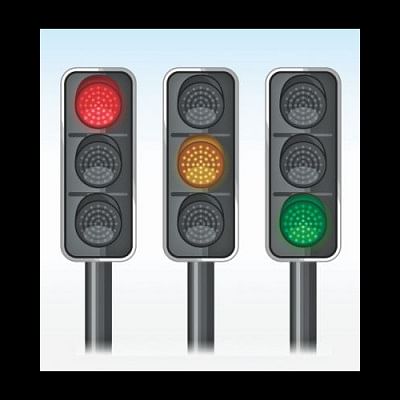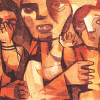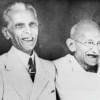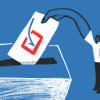May I have the left lane … please?

Much has been written about the monumental traffic jams that literally inflict physical, psychological, economic and emotional trauma on street users daily. For a trip that takes roughly 15-20 minutes during the wee hours or during Eid holidays, it literally takes 4-6 times longer at most other times.
Banality aside, the atrocious traffic mismanagement in our cities comes at a huge cost: in lost productive hours, economically wasteful burning of fuel, exasperating pollution, physical trauma, heat exhaustion, health externalities, and much more. The emotional costs are not trivial either. The seething anger in commuters that flares up occasionally is likely to grow in scale and intensity and people can be seriously hurt if a limit is crossed. Shootings have occurred in California's highways during traffic snarls.
To a large extent Dhaka City's traffic woes are behavioural and call for a behaviour change. I have said this before and wish to emphasise it again. When we go to our offices, we follow norms – of being timely, of dressing appropriately, of behaving with decorum, etc. There are norms at home which bring a sense of order within the family unit. In more regimented environments such as the military, discipline is paramount. Somehow, being on the streets unleashes within us a level of callousness, disrespect, aggression and unsavoury behaviour that seem to fit only the rule of the jungle. There are literally no norms; anarchy rules supreme.
I believe a few simple things can still be done to ease the misery. I have written about one idea – managing the street intersections where many of the travellers' woes originate (The Daily Star, Sept 18, 2015). Nothing has yet been done on this score. Here are a few additional ideas that could be given a try. I offer them if only for the record!
Visualise Manik Mia Avenue if you will. Going East to West, I want to turn left on Mirpur Road. Most of the time the left lane is clogged with traffic that will be turning right – buses, autos, cars, trucks, motorbikes, rickshaws – you name it. Now repeat this scenario for all left turning streets in Dhaka and you'll see how these blockages cause costly and irritating backups. If you look behind you, there are substantial empty spaces where the traffic could easily queue up and wait. Instead, the vehicles are driven all the way to the front, battling for every inch of space, thus blocking all lanes. I call this Q-Averse behaviour: these drivers will simply not form a queue.
For one thing, such behaviour represents a defiance of traffic rules. It is also a message to the traffic department that they can be shown the fat finger. It challenges their authority and taunts them to "let's see what you can do." Every single day these violators depict the traffic department as weak and impotent in enforcing traffic discipline. It is indeed an indirect and sordid rating of the calibre of the traffic management authority.
For another thing, the streets are being taken over by a new breed of unruly people who lack simple decency. They lack respect for others and their discourtesy is astonishing. Is this what we have become with development? Is this really development? Should development lead to anarchy?
What can we do about the growing breed of the Q-Averse? I propose a simple solution: the vehicles blocking the left lane MUST be made to turn left. But this cannot be done by the oft-harried "lone" traffic policeman who manages the intersection. He needs a team to support him. Obviously it is impossible to place teams of police officers at every intersection. Here is where special teams of 10-15 policemen (termed SSF – Swarm and Sting Force) with authority can show up at random intersections (especially where violations are most common) to direct all traffic as suggested including the flag-waving kind that is often a flagrant violator.
A second problem that arises is at the U-turns. In the first place, why are there so many U-turns on some major streets? And why are there so few traffic policemen (or none) at each of these U-turns, allowing the rebellious traffic to go crazy? Here is my second proposal: For each long stretch of road let there be fewer U-turns, but at each one let there be several traffic policemen. Their task would be to ensure that U-turns are only made from the right lane (street markings are vital here) and when such turns are being made, the oncoming traffic from the opposite direction is made to stop so that the two streams do not converge to clog up the intersection. Vehicles not in the right lane must be made to go straight on.
A third problem is that of public vehicles (buses, tempos, microbuses, etc.) that stop anywhere they please to pick up and drop off passengers. Sometimes several buses line up in parallel so that nothing can pass them by. Designated places must be properly marked for pick up and drop off. Special penalties must be imposed by the SSF on vehicles stopping at the intersections.
The final thing to be enforced is to stop vehicles going in the wrong direction, especially the ones that wave flags, sport stars, or display other markings (especially of some academic institutions) to signify their importance and assert their right to do wrong! Keeping them on the correct side of the street requires the backing of our highest offices; else the traffic policemen will continue to display clueless expressions or look the other way. By taking a strong stand on this matter, it will bode well for the city.
The above proposals focus on traffic management. However, there are deeper issues of traffic planning that also need to be addressed from a longer term perspective. Both must be made to work in tandem to solve the multitude of unpalatable problems that have mushroomed over the years while being systematically ignored.
It may also be mentioned that a variety of interest groups have continued to make use of the streets as a resource to be exploited (parking, beggars, street vendors, footpath stalls, etc.), thereby making the traffic experience so trying and unbearable. It is their minds and interests that need to be unclogged before our streets can be really unclogged and our experiences improved measurably.
The author is Vice Chancellor of BRAC University and Distinguished Professor Emeritus, Pennsylvania State University.

 For all latest news, follow The Daily Star's Google News channel.
For all latest news, follow The Daily Star's Google News channel. 






Comments